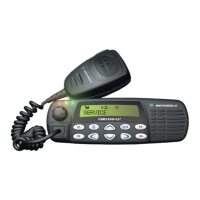_)
Theory of Operation 2-33
When the control head
IJP
wants to communicate to the host radio, the
IJP
brings request line
CH
REQUEST to a logic 0 via
IJP,
pin 62. This switches on 00823, which pulls line
ON
OFF CONTROL
high through diode D0821. A low to high transition on this line informs the radio, that the control
head requires service. The host radio then sends a data request message via BUS+ and the control
head
IJP
replies with the data it wanted to send. This data can be information such as a key is
pressed or the volume knob rotated.
The control head
IJP
monitors all messages sent via BUS+, but ignores any data communication
between host radio and CPS or Universal Tuner.
2.1
0.5 Keypad Keys
The control head keypad is a 6-key keypad (Model
B)
or
a 10- key keypad (model C). All keys are
configured as two analog lines read by
IJP,
pins
13
and
15.
The voltage on the analog lines varies
between 0 volts and +5 volts depending on which key has been pressed. If no key
is
pressed, the
voltage at both lines
is
5 volts. The key configuration can be thought
of
as a matrix, where the two
lines represent one row and one column. Each line is connected to a resistive divider powered by +5
volts. If a button is pressed, it will connect one specific resistor of each divider line to ground level
and thereby reduce the voltages on the analog lines The voltages
of
the lines are AID converted
inside the
IJP
(ports PE
0-
1)
and specify the pressed button.
To
determine which key is pressed,
the voltage
of
both lines must be considered.
An additional pair
of
analog lines and AID
IJP
ports (PE
3-
2)
is
available to support a keypad
microphone, connected to the microphone connector
J0811. Any microphone key press is
processed the same way as a key press on the control head.
2.1
0.6 Status LED and Back Light Circuit
All the indicator LED's (red, yellow, green) are driven by current sources.
To
change the LED status
the host radio sends a data message via SBEP bus to the control head
IJP.
The control head
IJP
determines the LED status from the received message and switches the LED's on or off via port PB
7-
0 and port
PA4.
The LED status is stored
in
the
IJP's
memory. The LED current
is
determined by
the resistor at the emitter
of
the respective current source transistor.
The back light for the LCD and the keypad is controlled by the host radio the same way as the
indicator LED's using
IJP
port
PA
5. This port is a Pulse Width Modulator (PWM) output. The output
signal charges capacitor C0843 through R0847. By changing the pulse width under software
control, the de voltage
of
C0843 and thereby, the brightness
of
the back light can be changed in four
steps. The keypad back light current
is
drawn from the
FLT
A+ source and controlled by transistor
00933.
The current flowing through the LED's cause a proportional voltage drop across the parallel
resistors R0947, R0948. This voltage drop is amplified
by
the op-amp U0931-2. U0931-2 and
00934
form a differential amplifier. The voltage difference between the base
of
00934
and the
output
of
U0931-2 determines the current from the base of the LED control transistor
00933
and in
turn the brightness
of
the LED's. The
IJP
controls the LED's by changing the de level at the base
of
00934. If the base
of
00934
is
at ground level,
00934
is switched off and no current flows through
00933
and the LED's. If the base voltage
of
00934
rises a current flows through
00934
and in turn
through
00933
causing the LED's to turn on and a rising voltage drop across R0947, R0948. The
rising voltage causes the output
of
the op-amp to rise and to reduce the base to emitter voltage
of
00934.
This decreases the current
of
00933
until the loop has settled.
2.10.7 Liquid Crystal Display (LCD)
The LCD H0971 uses the display driver U0971. The display is a single-layer super-twist pneumatic
(STN) LCD display. It has
14
characters with a 5*8 dot matrix for displaying
alpha-
numerical
information and a line with
21
pre-
defined icons above the dot matrix.

